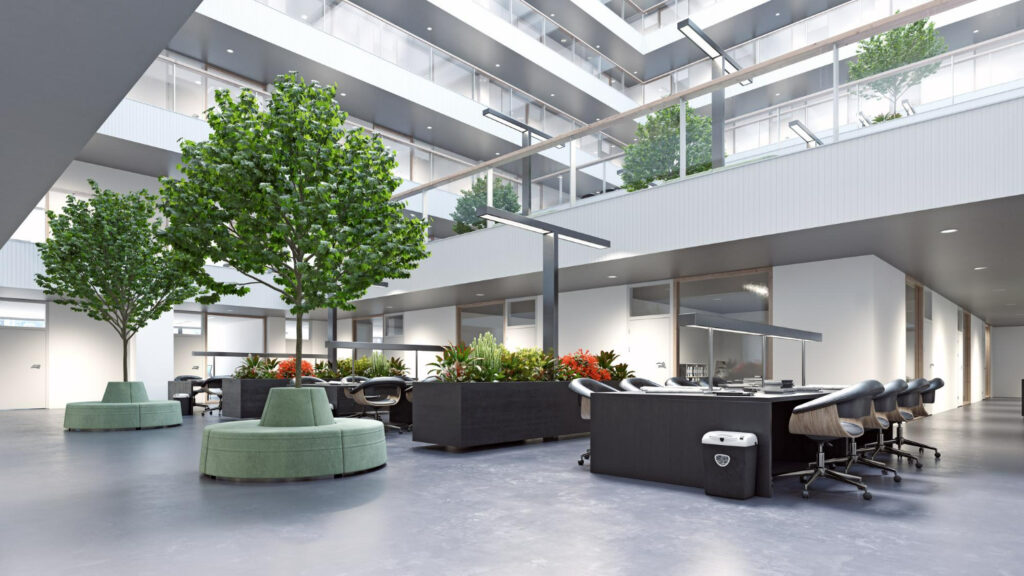Biophilic Office Design: How The Workspace Is Evolving

There is a new fashion for the workplace sweeping across the UK, which is biophilic design. The biophilic design concept helps increase people’s connection to the natural world, especially those working in the office, and uses many concepts from nature. This design philosophy, rooted in humans’ innate connection with nature, transforms workspaces into environments that promote well-being, creativity, and productivity. If your business is looking to refurbish an existing office or fit out a new workspace, consider this design concept to create a fantastic workplace for your employees.
The Essences Of Biophilic Design
Biophilic is derived from the Greek word’s “bios”, meaning life, and “philia”, meaning love, and it is a concept that recognises our deep-rooted connection with nature. In the office space, this translates into using natural elements like plants, natural light, and natural materials like wood and stone. When added together, these elements can help create a harmonious space ideal for working and can help boost productivity and the well-being of your employees.
Breaking The Concrete Jungle
With the advent of biophilic design for office space planning, gone are the days when the office space is a series of sterile cubicles that are uninspiring and reduces collaboration. The concept of biophilic design seeks to break the monotony of the concrete jungle, introducing elements that evoke the serenity of a forest or the tranquillity of a flowing stream. It makes the workplace seem more natural and comfortable and can profoundly affect your employees for the better.
Greening The Workspace
One of the most striking features of biophilic office design is the integration of greenery. Many examples include adding lush indoor plants, living walls, and even small gardens within the office space, and these are becoming increasingly common. The benefits of having plants in the office go beyond aesthetics; they contribute to improved air quality, reduce stress, help people concentrate, and enhance overall well-being. Moreover, natural materials such as wood and stone help create a warm and inviting atmosphere for employees and visitors to your workplace. These elements not only evoke a sense of connection with the outdoors but also add a touch of authenticity to the workspace.
Harnessing Natural Light
In pursuing biophilic design, architects and interior designers are paying close attention to the role of natural light within the workplace. Large windows, skylights, and open spaces are integral to modern office layouts and allow natural light to flood into the space. Allowing natural light to flood the workspace not only reduces the dependence on artificial lighting but also has a positive impact on mood and productivity.
Creating Spaces That Breathe
Biophilic office design is not just about adding greenery but creating spaces that breathe and evolve with the changing seasons and bringing nature indoors. These flexible workspaces can adapt to different tasks, and they make collaborative areas that encourage interaction, and these are becoming staples of biophilic design. This adaptability reflects the dynamic nature of natural environments and promotes a sense of freedom and creativity among employees.
Prioritising Employee Well-Being
The evolution of office design is not merely a matter of aesthetics; it’s a conscious effort to prioritise employee well-being. Biophilic design recognises the link between a healthy, natural environment and increased productivity and does everything possible to enhance that. Numerous studies have shown that exposure to nature, even in small doses, can reduce stress, boost creativity, and improve cognitive function. By creating workspaces that mimic natural settings, employers are fostering a culture that prioritises their workforce’s mental and physical health. This shift towards employee-centric design not only improves job satisfaction but also contributes to the retention of talent.
The Challenges & Opportunities
While adopting biophilic office design is on the rise, it comes with its own challenges. Incorporating natural elements requires thoughtful planning, and maintaining living features such as plants can be demanding. However, the potential benefits far outweigh the challenges. As technology continues to dominate the workplace, the need for human connection and a sense of purpose becomes increasingly important. Biophilic design bridges the gap between the digital and natural worlds, creating environments that inspire innovation and collaboration.
A Healthier & Happier Workspace
As the demand for healthier and more sustainable workspaces continues to rise, biophilic office design is poised to become a mainstay in the future of office architecture. Employers are increasingly recognising the importance of investing in the well-being of their employees, not only as a means of attracting top talent but also as a strategic move to boost productivity and creativity. The design principles align with this shift towards a more holistic approach to work. It enforces that the office is not just a space for tasks but a sanctuary that nurtures its occupants’ physical and mental well-being.
As we move forward, the integration of biophilic office design will undoubtedly continue to shape the future of work, providing a blueprint for a more sustainable, harmonious, and fulfilling workspace. If you are creating a new office space for your business, consider adopting the biophilic design principles and creating a fantastic workplace to boost your business.






